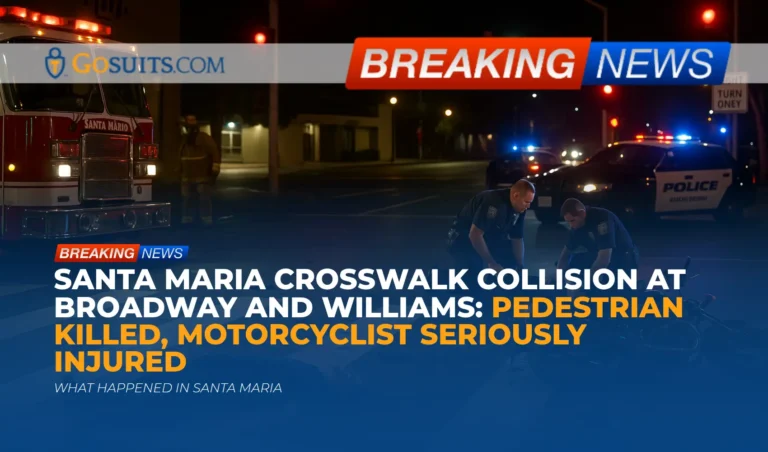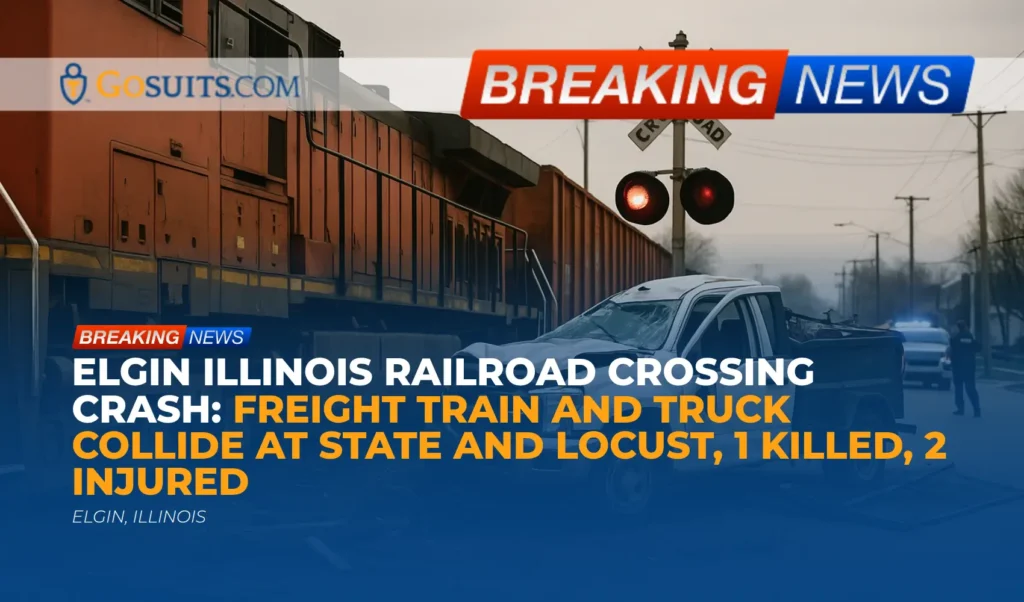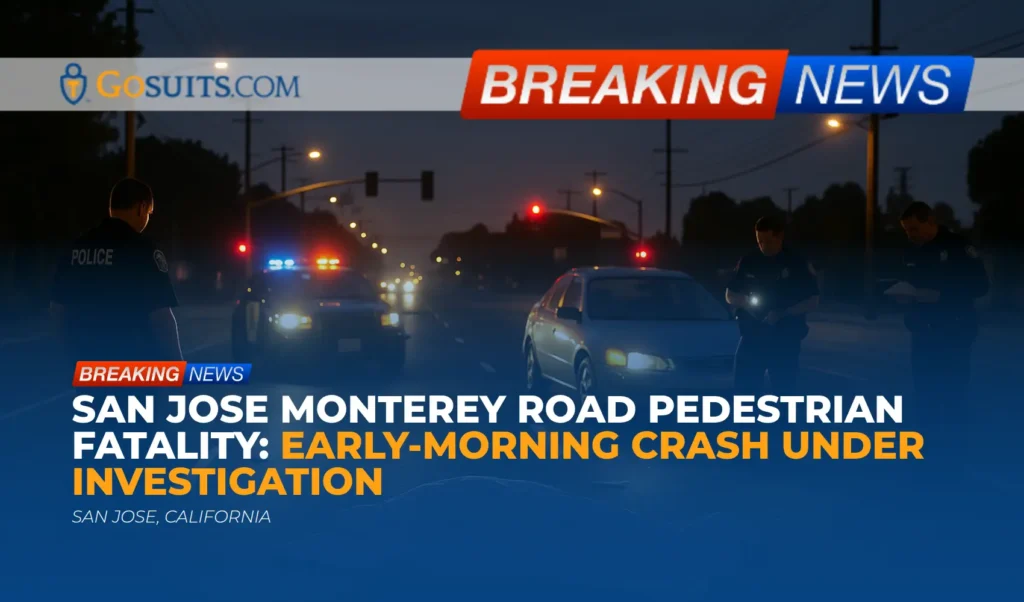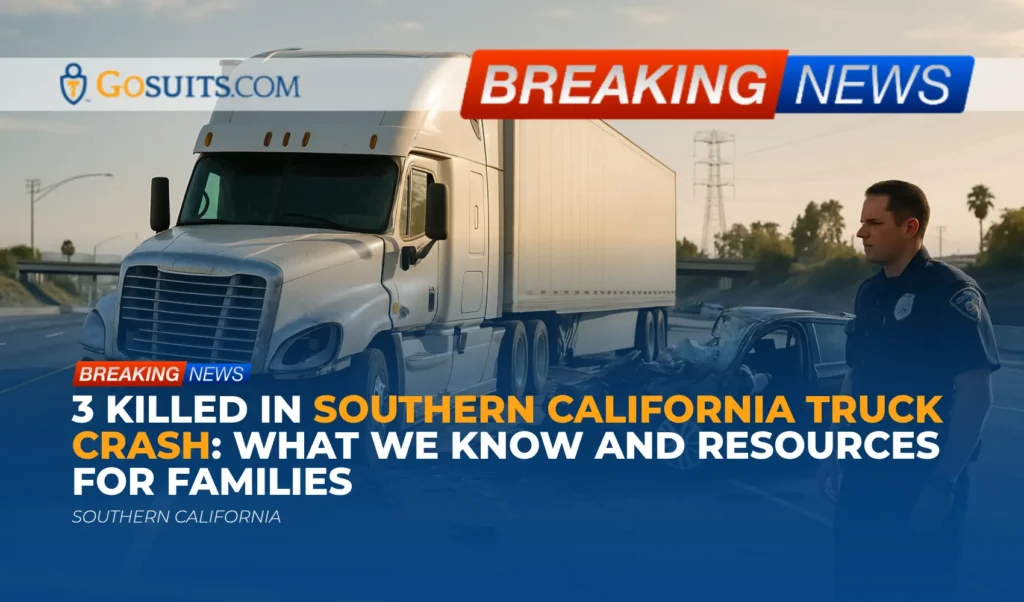- What happened in Santa Maria
- Where the investigation stands and what police have said
- Understanding potential civil liability after a pedestrian is struck in a crosswalk
- Rights of the injured rider and the bereaved family under California law
- Evidence that can matter in a pedestrian–motorcycle case
- Who to contact for official records and information
- How insurance coverage may apply
- Practical steps families and community members can consider
- Safety and prevention context
- Commentary from Gosuits Santa Maria, California Personal Injury Attorney
- Why prompt action matters after a serious pedestrian–motorcycle collision
What happened in Santa Maria
On a Saturday night in north Santa Maria, a tragic collision occurred at the intersection of Broadway and Williams Street. At approximately 8:35 p.m., emergency responders from the Santa Maria Police Department, Santa Maria Fire Department, and American Medical Response arrived to find both a pedestrian and a motorcyclist down in the roadway with significant injuries. The preliminary account from law enforcement indicates the pedestrian was crossing eastbound in the north crosswalk of Williams Street when a motorcycle traveling north on Broadway struck him. The force of impact reportedly threw the pedestrian to the pavement and ejected the rider. Both individuals were transported to Marian Regional Medical Center.
Despite medical efforts, the pedestrian, a 54-year-old Santa Maria man, died from his injuries. His name was withheld pending notification of relatives. The motorcyclist, a 32-year-old Santa Maria man, sustained serious injuries. Police noted that alcohol may have been a factor, and the roadway remained closed for several hours while the Police Department’s Traffic Unit investigated and processed the scene. Witnesses or anyone with information were asked to contact Officer Neil Medrano at 805-928-3781, extension 1139.
This is a heartbreaking event for the family who lost a loved one and for a community that shares their grief. It is also a difficult moment for the injured motorcyclist and his family, who face a long recovery. Our thoughts are with everyone affected.
Where the investigation stands and what police have said
According to police, the crash remains under investigation. Early statements indicate alcohol may have played a role, though formal determinations often depend on collision reconstruction, toxicology, scene measurements, and any camera or witness evidence. The Traffic Unit’s on-scene work typically includes photographing evidence, mapping the intersection, inspecting vehicle damage, and assessing lighting and visibility conditions at the time of the crash. The extended roadway closure suggests a thorough forensic process to document and preserve evidence.
As with any fatal collision, agencies usually obtain medical records, toxicology reports, and witness statements to understand the sequence of events. If alcohol impairment by a driver is eventually established, that fact is significant in both safety and civil-liability analyses. It is important to wait for verified findings rather than speculation. Families seeking updates should work directly with investigators and, when appropriate, consider securing counsel to help coordinate evidence gathering.
Understanding potential civil liability after a pedestrian is struck in a crosswalk
In California, drivers and riders have a duty to exercise due care for pedestrians, especially at marked and unmarked crosswalks. The California Vehicle Code requires drivers to yield the right-of-way to pedestrians crossing within a crosswalk, while also recognizing that pedestrians must not suddenly leave a curb into the path of a close vehicle and should not unnecessarily stop or delay traffic in a crosswalk. These complementary duties are outlined in California Vehicle Code section 21950, which emphasizes a driver’s obligation to exercise due care and the pedestrian’s duty to act safely as well. See California Vehicle Code § 21950 at leginfo.legislature.ca.gov.
California’s “basic speed law” also prohibits any person from driving at a speed greater than is reasonable or prudent, having due regard for weather, visibility, traffic, and the surface and width of the highway, and in no event at a speed that endangers the safety of persons or property. See California Vehicle Code § 22350 at leginfo.legislature.ca.gov. Although the posted speed limit is relevant, conditions at the time often matter just as much in assessing whether speeds were safe.
When a violation of a law designed to protect public safety is proven, California evidence rules allow a civil jury to consider that violation as creating a presumption of negligence, a concept commonly called “negligence per se.” See California Evidence Code § 669 at leginfo.legislature.ca.gov. Allegations involving alcohol or impairment, if substantiated by toxicology and other evidence, may be analyzed under this framework, because California law prohibits driving under the influence and sets per se blood alcohol limits for drivers. See California Vehicle Code §§ 23152–23153 at leginfo.legislature.ca.gov and leginfo.legislature.ca.gov.
California also follows comparative fault principles, meaning responsibility for damages can be divided among parties according to their share of fault. Even when a pedestrian is in a crosswalk, investigators and insurers may still evaluate conduct by all involved, including speed, lookout, lighting, vehicle position, and compliance with signals. The presence of alcohol, if verified, is a serious factor but does not eliminate the need for a careful, evidence-based analysis of every decision and condition contributing to the crash.
Rights of the injured rider and the bereaved family under California law
Two civil pathways often arise after a fatal pedestrian–vehicle collision: a wrongful death claim brought by eligible surviving family members, and a survival action brought by the decedent’s estate for certain losses that the decedent sustained prior to death. California’s statute of limitations for wrongful death is generally two years from the date of death. See California Code of Civil Procedure § 335.1 at leginfo.legislature.ca.gov. Distinct filing deadlines may apply to survival actions and, in some circumstances, to claims involving public entities.
For an injured motorcyclist, personal injury claims commonly seek recovery for medical care, lost income, and other losses caused by another’s negligence. The same two-year general statute typically applies, though specific facts can affect timing. If multiple parties contributed to the crash, responsibility may be apportioned among them.
No matter who was harmed, open and honest communication with insurance carriers can be important but also risky. Statements made to insurers can be used later to limit or deny claims. Before giving any recorded statement or signing any forms, it is prudent to speak with a qualified attorney in order to understand rights, obligations, and the potential long-term effect of early decisions.
Evidence that can matter in a pedestrian–motorcycle case
Determining how and why a collision occurred requires careful evidence preservation. In cases like this, key items may include:
- Police collision report and scene documentation. Reports often contain diagrams, measurements, and initial assessments. Follow-up supplements may add witness statements and results of any toxicology testing.
- Intersection video and nearby cameras. Public traffic cameras, transit buses, storefronts, and residential security systems can capture the moments before and after impact. Many systems overwrite quickly, sometimes in days, so prompt request letters are important.
- Vehicle and motorcycle inspections. Damage patterns, lighting function, brake condition, and data from aftermarket devices or smartphone apps can help reconstruct timing, speed, and angles.
- Medical records and imaging. Emergency department notes, CT scans, and operative reports can clarify impact mechanics and timelines, which matter in causation analysis.
- Toxicology and autopsy findings. Where applicable, coroner and hospital testing can inform impairment and causation assessments.
- Environmental factors. Lighting levels, weather, signage, signal timing, road geometry, and any obstructions can influence visibility and stopping distance.
- Witness accounts. Independent witnesses can clarify direction of travel, signal phases, speed, and behavior of both pedestrian and rider.
When families or injured people act quickly to secure evidence, it helps ensure a more accurate picture of what happened. Letters requesting preservation of video, vehicle inspections, and document retention are time-sensitive steps that representatives can coordinate.
Who to contact for official records and information
Families and community members often need official documents to understand what happened and to handle necessary affairs. These resources may help:
- Santa Maria Police Department Traffic Unit. Witnesses or anyone with information are invited to call Officer Neil Medrano at 805-928-3781, ext. 1139. Families can ask the Police Department about the status of the investigation and the process for requesting the collision report once it is available.
- Collision report requests. If a city police agency handled the scene, that department usually maintains the report. For incidents investigated by the California Highway Patrol, requests are made using CHP’s collision report process. See CHP collision report guidance at chp.ca.gov.
- Coroner and autopsy reports. In fatal cases, the county coroner has statutory duties to inquire into deaths and, when appropriate, perform examinations. See Government Code § 27491 at leginfo.legislature.ca.gov. Next of kin can contact the county coroner’s office to ask about certification timelines, autopsy findings, and how to request copies when legally available.
- Death certificates. Certified death certificates are often needed for estate and benefits matters. In California, they may be requested through the California Department of Public Health Vital Records; see state guidance at cdph.ca.gov.
- DMV accident reporting. Drivers and vehicle owners involved in a crash where anyone is injured or killed must file a DMV Form SR‑1 within 10 days, regardless of who was at fault or whether the damage was minor. See California DMV accident reporting requirements at dmv.ca.gov. Speaking with an attorney before submitting the form can help avoid statements that may later be misinterpreted.
- Victim compensation support. If law enforcement determines the death or injury was the result of a qualifying crime such as impaired driving, the California Victim Compensation Board may help eligible applicants with certain expenses, including funeral and counseling costs. Program information is available at victims.ca.gov.
- Medical records. Hospitals maintain treatment records that can be requested by the patient or by authorized next of kin or representatives under privacy rules. The U.S. Department of Health and Human Services provides an overview of health privacy rights at hhs.gov.
- Public records. Many agencies retain 911 audio, dispatch logs, and certain video under the California Public Records Act. Requests can be made in writing to the relevant agency. The CPRA is codified beginning at Government Code § 7920.000; see leginfo.legislature.ca.gov.
If a family plans to seek records, it is wise to ask about any fees, proof of relationship requirements, and estimated timelines. Some documents are only released when the investigation reaches certain milestones.

How insurance coverage may apply
Insurance issues after a pedestrian–motorcycle collision can be complex and vary with the facts and policies involved. Common coverages include:
- Liability coverage. If an insured rider or driver is found negligent, liability coverage is the primary source for bodily injury claims by an injured pedestrian or family members bringing a wrongful death claim.
- Uninsured/underinsured motorist (UM/UIM). If the at-fault party lacks sufficient insurance, UM/UIM coverage on the pedestrian’s own auto policy may apply to pedestrian injuries and, in some circumstances, to wrongful death claims for certain beneficiaries. Not every policy treats pedestrians the same way, so reading the policy language carefully is important.
- Medical payments coverage (Med-Pay). Some auto policies include no-fault medical payments coverage for immediate medical expenses, sometimes available to injured pedestrians.
- Health insurance and liens. Health insurers may pay medical bills initially but can assert reimbursement rights from any third-party recovery. Hospitals or government programs can also assert liens. Proper coordination helps avoid unexpected bills later.
Before calling any insurer, it is prudent to consult an attorney. Statements given to an insurance adjuster, even when intended to be helpful, can affect fault determinations and claim value. An initial free consultation can help clarify rights and the best sequence of steps.
Practical steps families and community members can consider
In the wake of a fatal or serious injury crash, tasks can feel overwhelming. The following actions are commonly helpful and time-sensitive. These are general suggestions and not instructions for any particular case:
- Coordinate with investigators. Keep a record of the investigating agency, report number if available, and the assigned investigator’s contact details. Provide any photos, video clips, or witness names your family has collected.
- Identify and preserve evidence. Request that nearby businesses and residences preserve camera footage. Save clothing, shoes, and personal items from the scene in a clean paper bag. Photograph any injuries promptly and over time.
- Document damages. Keep medical records, billing statements, proof of income, and funeral or memorial expenses. A simple folder or electronic drive helps keep items organized.
- Ask about autopsy and toxicology timelines. The coroner can explain expected timing and how results will be shared with next of kin.
- Consider retaining counsel early. Timely legal guidance can help with evidence preservation letters, public records requests, insurer communications, and understanding potential civil claims. Consulting an attorney before speaking with insurers is especially important, because what is said can be used later.
- Be mindful of deadlines. Calendar the two‑year wrongful death statute noted above and any shorter deadlines that may apply in special circumstances.
- Seek support. Grief counseling and community resources can make a difference. If the event is determined to involve a qualifying crime, the California Victim Compensation Board may help with counseling and funeral costs; see victims.ca.gov.
- Understand DMV obligations. For those legally required to file an SR‑1 after a crash with injury or death, see the California DMV’s requirements at dmv.ca.gov. Consult an attorney first if there are questions about how to complete the form.
Safety and prevention context
Serious pedestrian crashes are a persistent challenge across California and the nation. National data show that alcohol involvement remains a recurring factor in fatal pedestrian crashes, affecting drivers, pedestrians, or both. The National Highway Traffic Safety Administration provides research and safety recommendations addressing pedestrian risks and impaired driving; see NHTSA’s resources on pedestrian safety at nhtsa.gov and on drunk driving at nhtsa.gov.
California-specific data and safety initiatives are available through the California Office of Traffic Safety, which reports on collision trends and supports enforcement and education efforts statewide; see OTS statistics and research at ots.ca.gov.
Legal rules on right-of-way and due care exist because nighttime visibility, intersection design, traffic volumes, and human factors combine to create risk. Crosswalk awareness, obeying signals, and avoiding impaired driving are essential. At the same time, street lighting, signal timing, and speed management play significant roles in reducing serious harm, as captured in California’s basic speed law at leginfo.legislature.ca.gov. Community-driven safety improvements, including better lighting and high-visibility crosswalks, can save lives.
Commentary from Gosuits Santa Maria, California Personal Injury Attorney
Our hearts go out to the family grieving an unimaginable loss and to the rider facing serious injuries. We share this overview for educational and general information, hoping it helps neighbors understand the process that follows a devastating crash. It cannot capture the depth of the human loss, but it can help make next steps a little clearer.
From a civil injury standpoint, this collision raises familiar issues we see in crosswalk cases: right-of-way rules at intersections, the importance of speed appropriate to conditions, and the grave implications if impairment is ultimately confirmed. California law expects every road user to exercise due care. When a pedestrian is lawfully within a crosswalk and is struck by a vehicle or motorcycle, investigators closely examine visibility, lookout, signal phases, and whether any safety statute was violated. Evidence must lead the analysis. The early indication that alcohol may have been a factor, if supported by testing and corroborated evidence, would weigh heavily in assessing negligence under California’s rules, including the negligence per se framework referenced in Evidence Code § 669.
In the aftermath of a crash like this, insurance companies often move quickly to gather statements and shape the narrative. Corporations and insurers manage claims every day; families do not. Adjusters are trained to ask questions in ways that can narrow or shift fault and to secure authorizations that give broad access to private records. Small inconsistencies can later be used to challenge credibility or reduce damages. That is why it is prudent to consult an attorney before giving any recorded statements, completing insurer interview forms, or signing medical releases. Understanding rights early helps keep the process fair.
A free consultation can help answer immediate questions: how to preserve evidence before it disappears, how to request the right records, which deadlines matter, and how insurance coverages might interact. There is no obligation to take any action after a consultation, but having clear information early can prevent missteps that are hard to undo later.

Why prompt action matters after a serious pedestrian–motorcycle collision
- Secure time-sensitive evidence. Many traffic and security cameras overwrite footage within days. Early preservation letters to businesses, residences, and public agencies can be the difference between having clear video or relying only on memory.
- Protect the accuracy of the record. Collision reports may be supplemented as new facts emerge. Promptly sharing witness information, photographs, and medical updates helps investigators and reduces the risk of critical details being lost or misunderstood.
- Avoid harmful statements to insurers. Early conversations with insurance adjusters may feel routine, but statements are recorded and can be used later. Speaking with an attorney first helps ensure communications are careful and complete.
- Meet legal deadlines. Statutes of limitation and notice requirements are strict. Missing a deadline can end a claim regardless of its merits. Early planning ensures calendars are set and obligations are understood.
- Coordinate benefits and bills. Health insurance, medical payments coverage, and potential victim compensation benefits each have specific rules. Timely coordination prevents gaps in care and unexpected expenses.
- Support grieving and recovery. Accessing counseling and community resources early can aid emotional recovery. When a collision is later determined to involve a qualifying crime, the California Victim Compensation Board may assist with counseling and funeral costs, helping to ease immediate burdens.
- Plan for long-term needs. Serious injuries can require months of care and lost income. Early guidance helps document losses properly and plan for rehabilitation, wage replacement documentation, and supportive services.
Key California resources referenced above
- California Vehicle Code § 21950 (drivers and pedestrians at crosswalks): leginfo.legislature.ca.gov
- California Vehicle Code § 22350 (basic speed law): leginfo.legislature.ca.gov
- California Vehicle Code §§ 23152–23153 (DUI laws): leginfo.legislature.ca.gov and leginfo.legislature.ca.gov
- Evidence Code § 669 (negligence per se): leginfo.legislature.ca.gov
- Code of Civil Procedure § 335.1 (two‑year statute for wrongful death): leginfo.legislature.ca.gov
- Government Code § 27491 (coroner duties): leginfo.legislature.ca.gov
- California DMV accident reporting (SR‑1 within 10 days): dmv.ca.gov
- CHP collision report request: chp.ca.gov
- California Victim Compensation Board: victims.ca.gov
- CDPH Vital Records (death certificates): cdph.ca.gov
- NHTSA pedestrian safety: nhtsa.gov
- NHTSA drunk driving: nhtsa.gov
- California Office of Traffic Safety statistics: ots.ca.gov
- U.S. HHS HIPAA privacy overview: hhs.gov






